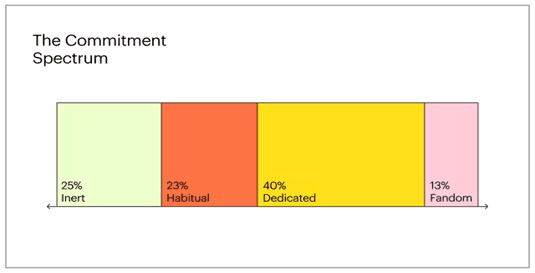Retailers around the world are facing challenges on multiple fronts. The global economy continues to face disruption, impacting consumers’ spending power. And it doesn’t appear to be subsiding soon, with expectations of further rises in shipping costs that retailers may have to pass on to their customers during the 2024 holiday shopping period. Alongside this, misinformation continues to impact what consumers see online, making it harder to know what is legitimate.
When coupled with the increasing choices on offer, growing a customer base has never been harder. Loyalty is a strategic imperative for success. But is brand loyalty really what retailers and their marketing teams expect it to be?
According to Intuit Mailchimp’s Science of Loyalty research, which surveyed 4,000 consumers in the US, UK, Australia and Canada, over a quarter (28%) of British repeat purchases are made due to routine and 20% occur simply because a brand or product was readily available, and 3% said it is due to the inconvenience of switching. It demonstrates the power of convenience and sticking with the familiar—and how difficult it can be to entice customers to drop old habits and switch to a different brand’s products.
However, there is also evidence to suggest that personal preferences can drive purchasing behaviours. Two-fifths (42%) of UK repeat purchases happen because customers actively prefer one brand to another—the most popular response. And a small but committed group of real ‘fans’ are even willing to go out of their way to seek out a brand’s product (6%). Clearly, there is a point at which convenience and love intersect to drive repeat purchases.
Growing trust builds loyalty
Recognising the need for a brand to be trusted is paramount to successfully building both loyalty and revenue opportunities. In the UK specifically, the research found that 80% of those surveyed said they would only buy from a brand if they knew it was trustworthy, and 65% said they shared values with their preferred brand.
Diving deeper, catalysts to increase re-purchasing include if a brand consistently matches the standards consumers expect (41%), is one they know well (37%), is quick and easy to purchase from (34%) and makes them feel good (20%). These all rank above the need for special deals and discounts at 17%. Brands and retailers must sit up and take notice. A discount or one-off commitment to sustainable practices is simply not enough for British consumers today, even in the current economic climate. Consumers need to know that the brand is proactively taking steps to demonstratevalue beyond boosting the share price.
Part of growing that trust lies in how retailers and brands communicate and connect with shoppers. For example, almost half (47%) of UK repeat customers said recommendations from friends and family help them decide what to buy, creating a potentially valuable conduit to engage new customers. If brands can genuinely alignwith customers’ values and interests, they have the potential to embed themselves with those shoppers, converting them into advocates who will encourage their peers and communities to buy as well.
Understanding the commitment spectrum
Loyalty falls on a spectrum, with consumers ranging from those who are making a one-off purchase right through to the most devoted repeat customers. Initially, customers may be classed as “inert” and buy simply out of convenience. Those who often buy from the same brand out of routine are classed as “habitual.” This is followed by the ‘dedicated” shoppers, who may have an emotional connection to the brand’s vision. Finally, there is a small but important group of “fandom” shoppers, who can be your biggest brand advocates.

While the “fandom” group may seem the pinnacle of every brand’s goal, the research found that only 13% of all global respondents fit within this section. While this most committed group could individually be big spenders, they’re unlikely to be the biggest revenue drivers overall, so it’s important to consider tactics that can engage consumers across the spectrum.
Tactics to harness loyalty
Each brand’s path to growing loyalty will be different, and so will the tactics and strategies they need to deploy to get there. However, there are a few that can be universal for every retailer’s plans:
- Familiar foundations: Build familiarity by showing up in trusted spaces, such as through friends and family. Offering “recommend a friend” codes as part of a reward scheme, for example, can entice new shoppers and give back to loyal fans.
- Choice validation: To ensure ongoing commitment from customers, help them feel justified in the purchase choices they make. That could include making it look like they’re getting a deal by coming back for more purchases.
- New routines: Make regular purchases easy for customers to encourage new routines. This can be as simple as enabling one-click purchases or subscription models. Globally, the research found that 35% of those who purchase on a daily or weekly basis said their preferred brand was the only one they’d consider (compared to 22% among those purchasing monthly or less). By removing those barriers that can disrupt the shopping journey, retailers and brands can increase conversion.
- Meaningful rewards: Wherever possible, rewards programmes must be personalised to the customer, such as relevant deals and offers, that help them feel recognised as individuals. This can be further extended by gamifying rewards to drive engagement further.
- Sense of ownership: Feedback forms, proactive updates for queries they may have, and a focus on providing best-in-class customer experience can all bring customers closer to the brand so they feel listened to and engaged.
Loyalty is more important than ever, and understanding its nuances can be make-or-break for retailers and brands. However, building loyalty takes time and understanding. It may be easier to sell to those in the “fandom” group, but focusing on this group at the expense of the others can offer diminishing returns. With the right mix of tactics—and with trust as a guiding principle—smart marketers can appeal to users across the commitment spectrum and build relationships that last.


